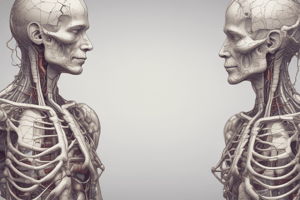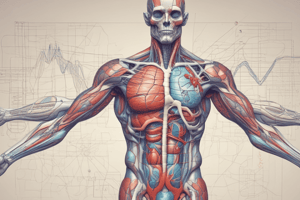Podcast
Questions and Answers
What does the word 'Physio' in Human Physiology mean?
What does the word 'Physio' in Human Physiology mean?
Function
What does the word 'Logy' in Human Physiology mean?
What does the word 'Logy' in Human Physiology mean?
Science
Which of the following is the smallest basic structural unit of the human body?
Which of the following is the smallest basic structural unit of the human body?
- Organ
- Cell (correct)
- Tissue
- System
What is the total body water as a percentage of body weight in young adult males?
What is the total body water as a percentage of body weight in young adult males?
How much total body water does a young adult male weighing 70 kg normally have?
How much total body water does a young adult male weighing 70 kg normally have?
What fraction of total body water is represented by intracellular fluid (ICF)?
What fraction of total body water is represented by intracellular fluid (ICF)?
What is the volume of extracellular fluid (ECF) in litres for a 70 kg male?
What is the volume of extracellular fluid (ECF) in litres for a 70 kg male?
Which cation is mainly found in extracellular fluid (ECF)?
Which cation is mainly found in extracellular fluid (ECF)?
Match the body fluid with its main cation:
Match the body fluid with its main cation:
What is one of the functions of body water?
What is one of the functions of body water?
What is the structural component that forms the outer boundary of a cell?
What is the structural component that forms the outer boundary of a cell?
What type of permeability does the cell membrane exhibit?
What type of permeability does the cell membrane exhibit?
What is the thickness of the cell membrane in angstroms?
What is the thickness of the cell membrane in angstroms?
Which component is NOT part of the chemical structure of the cell membrane?
Which component is NOT part of the chemical structure of the cell membrane?
Flashcards
Human Physiology Definition
Human Physiology Definition
The science of how the human body functions under various conditions to sustain life.
Cell (human body)
Cell (human body)
The smallest structural unit of the human body.
Tissue (human body)
Tissue (human body)
A group of cells with similar structure and function.
Organ (human body)
Organ (human body)
Signup and view all the flashcards
Body System
Body System
Signup and view all the flashcards
Total Body Water (TBW)
Total Body Water (TBW)
Signup and view all the flashcards
Intracellular Fluid (ICF)
Intracellular Fluid (ICF)
Signup and view all the flashcards
Extracellular Fluid (ECF)
Extracellular Fluid (ECF)
Signup and view all the flashcards
Cell Membrane Function
Cell Membrane Function
Signup and view all the flashcards
Cell Membrane Structure
Cell Membrane Structure
Signup and view all the flashcards
Study Notes
Human Physiology - Introduction to Body Fluid Compartments
- Physiology is the study of how living things work.
- It involves examining functions in various conditions.
Human Body Organization
- The cell is the smallest basic unit.
- Tissues come from similar cells working together.
- Organs contain multiple tissues to perform specific functions.
- Systems are made of various organs working for a shared goal.
Examples of Body Systems
- Cardiovascular
- Respiratory
- Urinary
- Digestive
- Endocrine
- Nervous
- Reproductive
- Musculoskeletal
Body Fluids
- Approximately 60% of a young adult male's weight is water.
- Intracellular fluid (ICF) makes up about 2/3 of total body water.
- Extracellular fluid (ECF) accounts for the remaining 1/3.
- ECF subdivisions include intravascular (blood plasma), and extravascular (interstitial/transcellular) fluids.
- Interstitial fluid fills spaces between cells.
- Transcellular fluids are located in closed spaces.
Composition of Body Fluids
- ICF is rich in K+ and proteins.
- ECF contains more Na+ and Cl−.
Osmolarity Function
- Water is crucial for chemical and enzymatic reactions.
- It's a medium for diffusion and filtration.
- Facilitates pH regulation.
- Maintains body temperature and lubrication.
- Acts as a reflective medium and a mechanical buffer for organs like the brain.
- Necessary for gas exchange in lungs and tissues.
Human Cells - Cell Membrane Structure and Function
-
Cell membrane acts as a protective barrier, separating internal from external environments.
-
It is selectively permeable, controlling substance entry and exit.
-
The cell membrane is extremely thin, approximately 75 angstroms.
-
Composed of phospholipids, proteins, and carbohydrates.
-
Phospholipids:
- Have hydrophilic (water-loving) heads and hydrophobic (water-fearing) tails.
- Form a phospholipid bilayer, the core of the cell membrane.
-
Proteins:
- Determine cell membrane functions.
- Can either be peripheral (on the surfaces) or transmembrane (integrated).
- Include channels for transport, receptors for signals, and enzymes.
-
Carbohydrates:
- Often attached to proteins (glycoproteins) or lipids (glycolipids).
- Involved in cell-cell recognition and communication.
Functions of Cell Membrane Proteins
- Act as receptors (respond to hormones/chemicals) and recognition sites (self/non-self).
- Form pores (channels) for specific substances.
- Are pumps to move substances against gradients.
- Are enzymes.
- Function as an active support structure.
Types of Cell Membrane Channels
- Non-gated channels are always open.
- Gated channels open or close depending on stimuli (voltage, ligands, mechanical pressure).
Carbohydrates of the Cell Membrane
- Form the glycocalyx—a carbohydrate-rich layer outside the membrane.
- Functions in cell recognition, adhesion, and protection.
Studying That Suits You
Use AI to generate personalized quizzes and flashcards to suit your learning preferences.


